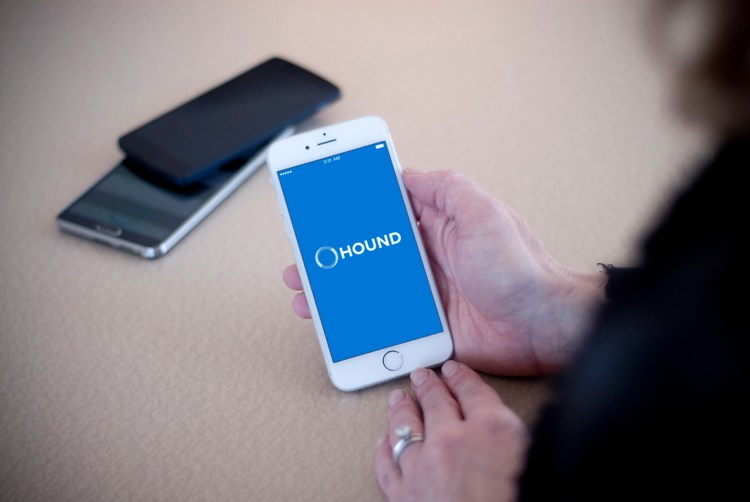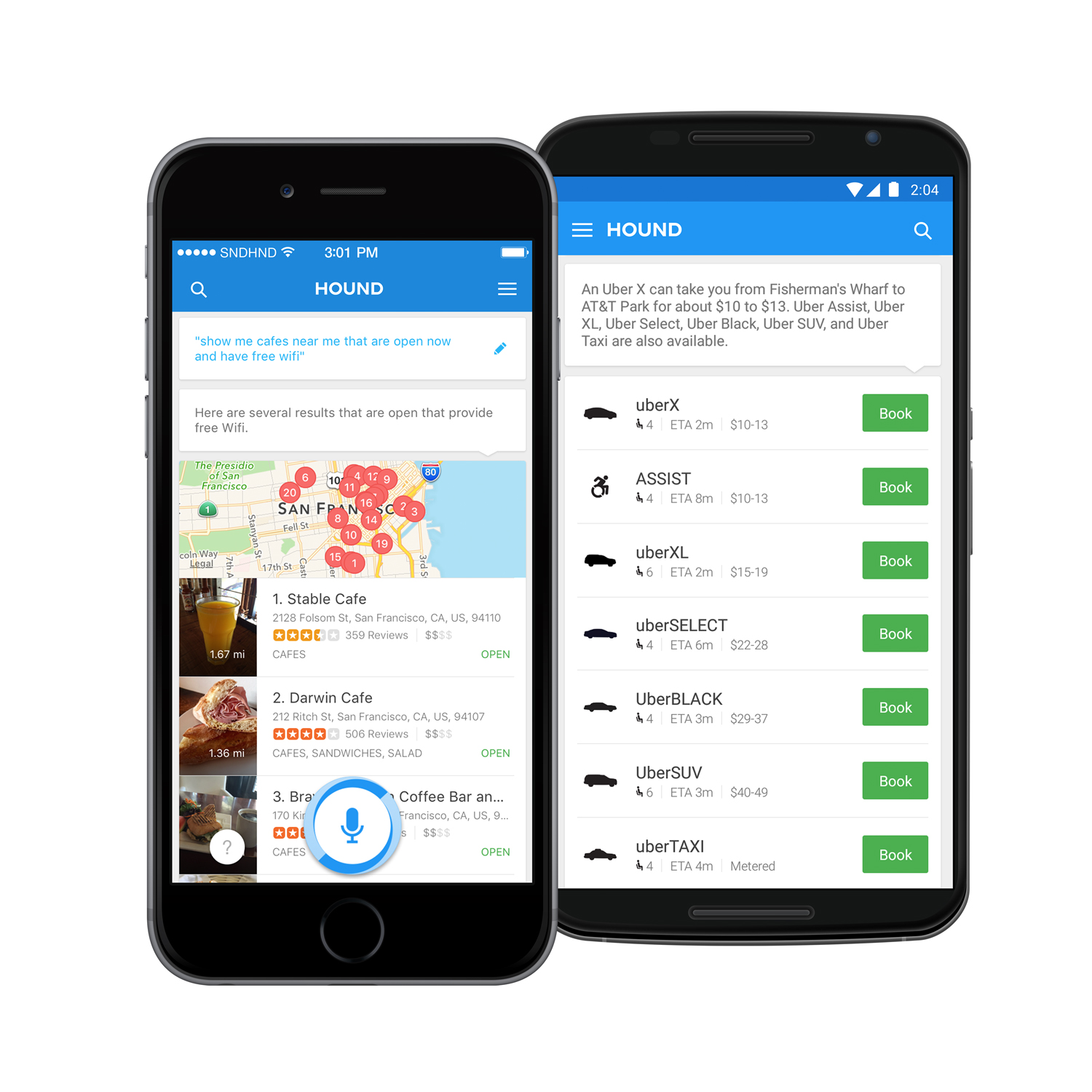You may have thought that SoundHound had long ago ridden into the sunset, but you’d be wrong. Although its signature app has been focused on music search for the past decade, that’s all about to change with the emergence of Hound out of beta. Hound is a natural language virtual assistant built off of the company’s proprietary platform. In other words, SoundHound is taking on Apple’s Siri, Google Now, and Microsoft’s Cortana.
Word first spread about Hound last June when it began accepting applications for its private beta. At the time, SoundHound was hoping for 1,000 testers, but in two months, it had 300,000 applications from all over the world. Today, not only has the Android version become available to all, but the company has also released an iOS version of the app.
In addition, the company has added two new partners to the mix, integrating Yelp and Uber into its app. In total, Hound has more than 100 domains (services it has tied), double the number it had when the app was still private.
Introducing the challenger
Billed as being faster and more accurate than the incumbent assistants, Hound utilizes speech-to-meaning recognition technology that was built using SoundHound’s Houndify developer platform. Keyvan Mohajer, the company’s president and CEO, told us that while Siri, Google, and Cortana have similar technology, theirs is currently broken up into two parts: speech-to-text and text-to-meaning. He believes this causes issues with speed and accuracy: “If you make a mistake in speech-to-text, you’ll have the wrong input in the next step.”
Mohajer also claimed that Hound can understand more complex questions, eliminating the need for short keyword-based queries. “This has enabled users to be more demanding and get what they want,” he said. “We want people to be power users. No more dumbing down to the level of Siri and Google Now.” In a demo, Mohajer ran through some complex interactions, starting with asking about the day’s weather and leading into a variety of logic-based questions that you’d expect ordinary people to have. The app was fast and was able to understand each question in its context.
In the more than seven months since it was unveiled, Hound has also expanded from the 50 services it was originally integrated with to the current 100. These include weather, currency translation, voice dialing and texting, nutrition, music, navigation and directions, reference, video search, unit conversion, word and phrase translation, and sports scores. Mohajer said the number of tie-ins exceeds Siri’s and noted that Apple’s smart assistant launched with 12 domains and took five years to double that. Hound and other assistant-type apps, Mohajer explained, “become more useful when you add more domains.”
Some partnered integrations in Hound include Expedia, AccuWeather, Xignite, and FlightStats. Uber and Yelp are the latest to have tied their respective APIs into the app. With the former, you’re able to request an Uber using your voice, receive price estimates, and more all within SoundHound’s app. The latter partnership taps into Yelp’s database for local searching.
Hound can be accessed either by pressing a microphone button in the app or by saying “Ok Hound…” Mohajer said that while the service is always listening, nothing’s being recorded on the server level. You’ll have to get used to the workflow, however — instead of tapping on the home button or uttering a phrase, you’ll need to first open the app and then either say “Ok Hound…” or press the microphone button.
Here are some examples of complex queries you can put to Hound:
- “Show me coffee shops with Wi-Fi” and “Which ones are within walking distance and are open after 9 p.m. on Sundays?”
- “What’s the weather?” “How about tomorrow morning in Austin, Texas?” “How about two months from now?”
- “Show me hotels in San Francisco for tomorrow staying for two nights that cost between $200 and $300 per night and are pet-friendly and have a gym and a pool.”
- “What’s the monthly payment on a $1.2 million home with 20 percent down, paid over 30 years with a 3.95 percent interest rate?”
What it won’t do right now, unfortunately, is sync with your iOS calendar (though it works on Android) or read the emails you have, though Mohajer said those features are coming soon. However, it can compose a message if you want. Additionally, 3D Touch is supported on Hound’s iOS app.
You don’t have to speak geek
SoundHound knows that it has a tough task ahead of it, especially going after services that are integrated into the core operating system. Kathleen McMahon, the company’s general manager and vice president, told us that she hopes to appeal to early adopters and those who haven’t used voice before.
The former is not a trivial matter for SoundHound, especially since it requires changing someone’s existing behavior. McMahon believes that when a user has their first experience with the app and sees that it’s faster and more accurate, they will be likely to adopt it: “You have to have a step change and sensation so that they’re going to have their mind blown,” she said. “If you really sense the speed and accuracy, that’s great, but you also have to take away the pain of change and pain points of using the existing products.”
The company has also set its focus on working with the mass market: “SoundHound is a deep tech company that isn’t forcing the geek world on you. You’d speak like you would to your friend,” McMahon explained.
SoundHound’s next audience involves those that are new to voice commands and haven’t adopted any established behaviors. Its competitor in this space is the thumb and finger.
Houndifying everything
One of the core elements of the app is Houndify, the company’s developer platform, which will eventually not only allow developers to build domains and apps that sync with the Hound app, but eventually integrate into other connected devices.
Mohajer said there are two types of developers the platform works well for. There are those that want to enable products to have a voice interface — such as those that want to incorporate it into their refrigerators, smart mirrors, or even create an Amazon Echo competitor. On the other side are those that want to create domains for Hound. SoundHound is looking to rapidly grow the number of services that integrate with its app, with Mohajer hoping for 1,000 tie-ins.
The platform debuted on December 15 and now lets anyone “houndify” their products using the domain. Mohajer cited an example where a colleague “houndified” an espresso machine so that while a drink was being made, you could interact with the device and and ask what the weather was like, hear the news, and more. A few weeks after the platform’s release, thousands of companies signed up to try it out, with some even demonstrating their enhanced product at the Consumer Electronics Show in Las Vegas, Calif. this year. A notable example was Nvidia, which incorporated Houndify into its DRIVE CX platform in car dashboards, and Samsung, which included Houndify in its ATRIK platform to power Internet of Things devices.
SoundHound said that the Houndify platform opened up to allow others to create products around existing domains, but added that soon you’ll be able to create your own domain and monetize it. The company declined to provide a specific date.
Part of the vision
For a decade, the company has been known for its namesake application, but Mohajer said this next step in its evolution has always been part of the company’s vision. In the beginning, the company’s investors wanted it to be strictly business, not involved in research and development. They wanted it to focus on delivering things in three years not five to 10. That’s how the SoundHound music app came into being — it was successful and made the company money.
But when Mohajer went back to investors later on, he told them “the world will be ready for Hound, and it’ll be hot,” and received the board’s blessing to pursue his research. The company established a stealth lab to create the core technology needed to produce a product that the company believes can shape a user’s behavior.
Hound is free to use, but if you request an Uber or book a hotel, SoundHound receives a percentage of that transaction. In addition, it’ll receive revenue when you search for a song and buy it. We’re told that in the future, those apps and products that have been “houndified” will be monetized in similar ways.
You can download Hound for iOS and Android today.









